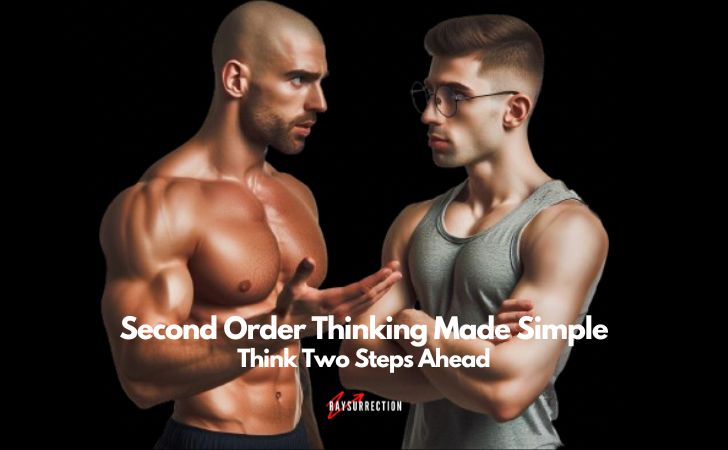Most people think like they’re playing checkers—one move at a time. You make a choice, see what happens, and stop there. But life isn’t that simple. Every decision has layers, and those layers stack up in ways you might not see right away. Second order thinking is about looking beyond the first thing that happens. It’s like playing chess—thinking ahead and seeing how today’s choices shape tomorrow. Let’s break it down.
First Order Thinking: Why It’s the Default
First order thinking is all about instant results. It’s the easiest way to make decisions because you only focus on what’s directly in front of you. It’s simple and fast, but it misses the bigger picture.
- You’re hungry, so you grab a fast-food burger. Problem solved, right? Sure, you’re full now, but what about next week if this becomes your daily routine?
- You want to buy a new phone, so you swipe your credit card without thinking. Cool, you have the phone now, but next month, that bill hits, and suddenly you’re stressed.
- You hate studying, so you skip it to watch TV. Fun in the moment, but now you’re unprepared for the test, and your grades start slipping.
First order thinking feels great in the short term. It’s easy to stay here because it doesn’t require much effort. But it also means you end up blindsided by the long-term consequences.
Second Order Thinking: Looking Beyond the Immediate
Second order thinking takes a step back. Instead of just reacting, you think about what comes next and what happens after that. It’s like seeing how your choices connect to everything else.
- You’re deciding between walking or driving to school. Walking takes longer, but it’s good exercise, saves money on gas, and keeps your car in better shape. Driving is faster, but it adds to wear and tear, uses gas, and means less movement in your day.
- You’re at the store, tempted to buy another gadget. First order thinking says, “I want this.” Second order thinking asks, “Do I actually need it, or will it just take up space?”
- Someone offers you an easy way out of a problem. First order thinking says, “Take it.” Second order thinking wonders, “What strings are attached?”
This kind of thinking isn’t about being paranoid or overcomplicating everything. It’s about connecting the dots and asking a simple question: “What happens after this?”
Actions and Their Consequences
Every decision has layers. One choice triggers another, and that one keeps the chain going. If you only think about the first result, you miss what comes next.
- You stay up late scrolling on your phone. Sure, it’s fun at the moment, but then you’re exhausted the next day, which affects your mood, energy, and focus.
- You spend all your money on a shopping spree. It feels good now, but what happens when a real expense shows up, and you’re broke?
- You skip doing chores. It’s fine for a day, but before you know it, you’re drowning in a mess that takes hours to clean up.
It’s like each choice you make sets off a chain reaction. Thinking about those future steps changes how you approach decisions.
Practical Ways Second Order Thinking Shows Up
This way of thinking isn’t just about big, life-changing decisions. It shows up in everyday stuff too.
- Imagine you’re picking a college major. First order thinking might focus on what sounds fun or interesting right now. Second order thinking looks at how that choice affects your career options and future plans.
- You’re deciding how to spend your free time. First order thinking says, “Do whatever’s fun in the moment.” Second order thinking considers, “Will I feel good about this choice later, or will I regret not using my time better?”
- You’re in a disagreement with a friend. First order thinking says, “Say what I’m feeling right now.” Second order thinking asks, “How will this conversation affect the relationship in the long run?”
It’s not about freezing up or overthinking every little thing. It’s about taking a second to consider where your decisions might lead.
Why This Way of Thinking Feels Like Chess
Think of chess. You’re always planning ahead, thinking about what your move sets up for the next turn. That’s how second order thinking works.
- Someone offers you a quick solution to a problem. Instead of grabbing it, you ask, “What’s the trade-off?”
- In group projects, you could let someone else take the lead. But if they mess up, the whole group suffers, and so does your grade. Taking responsibility now might save a headache later.
- Friendships are the same way. Spending time with people who bring drama or negativity may seem fine in the moment, but over time, it weighs on you. Choosing to surround yourself with positive influences changes everything.
Second order thinking is less about reacting and more about seeing the bigger picture.
How Small Choices Add Up
Sometimes it’s the little things that show how second order thinking works. Small decisions often stack up in ways you don’t notice until it’s too late.
- You skip working out one day. No big deal, right? But then it becomes two days, then a week, and suddenly, the habit is gone.
- You hit snooze instead of getting up early. It feels harmless, but now you’re rushed all day, and your schedule falls apart.
- You keep putting off studying. At first, it’s just one night. Then you’re cramming at the last minute, stressed out, and unprepared.
The idea is that small choices build on each other. Second order thinking helps you spot how those small things can either work for you or pile up against you.
Making Second Order Thinking Simple
Here’s the cool part—it doesn’t have to be complicated. This way of thinking is just about pausing for a moment and looking past the first layer.
- Think about habits. Skipping one workout or procrastinating one task may seem like nothing now, but it’s easy to fall into a pattern. Thinking ahead helps keep things in check.
- Look at your decisions about money. Buying something impulsively feels great for a second, but thinking ahead shows how those purchases add up over time.
- Consider relationships. Being mindful of how your actions affect others builds stronger connections in the long run.
Second order thinking is really just asking yourself, “What happens next?” and keeping that in mind when you make choices.
Wrapping It Up
Second order thinking isn’t some complicated strategy. It’s just a way of seeing how everything connects. By thinking two steps ahead, you start noticing how decisions today shape what happens tomorrow. It’s not about being perfect—just being aware enough to make better choices.




